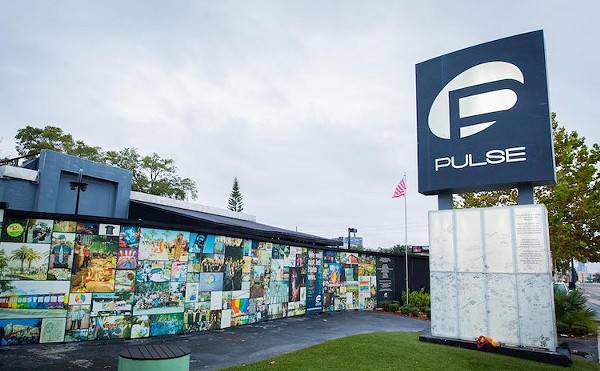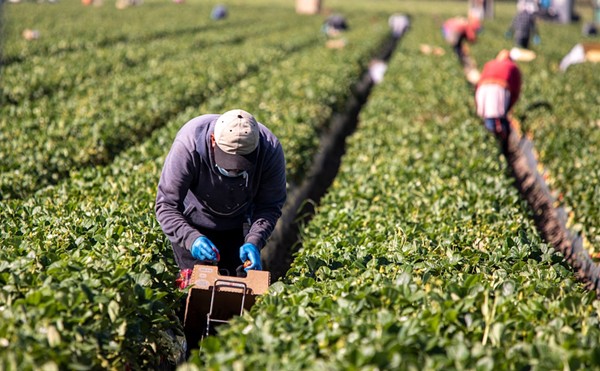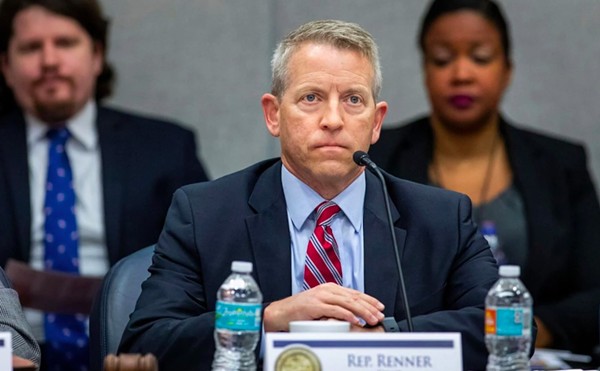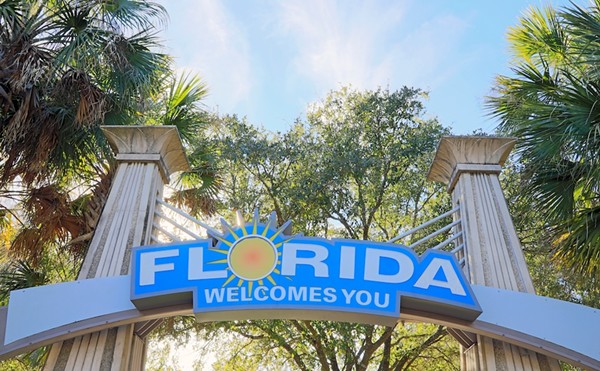When history gets around to judging John H. "Buddy" Dyer's administration — probably the next time he runs for statewide office — the resurgence of downtown Orlando will be the big story. Forget about his short-lived indictment or the mini-scandals and faux pas that decorated his early years.
Downtown will either be the banister Buddy hangs onto as he climbs into the political stratosphere or an anchor tied to his neck. If it's the former, he should really send Frank Billingsley a thank-you note.
For the last four years, Billingsley, as executive director of the Downtown Development Board and Community Redevelopment Agency, has overseen downtown's overhaul. Every scrap of new construction you see along Orange Avenue, from Cameron Kuhn's Premiere Trade Plaza to the condominium complex at 55 W. Church Street, has Billingsley's thumbprint on it.
He's also been party to some of the city's more controversial dealings, like Lou Pearlman's lackluster renovation of Church Street Station and the generous incentive package the city gave Kuhn. And things haven't been all rosy: Despite decades of effort, Parramore is still one of the city's poorest and most dangerous neighborhoods.
After four years, Billingsley is being promoted. Following a July 10 city council meeting, Billingsley will take over as the city's economic development director, and the city will begin looking for his replacement. We talked with Billingsley about the challenges of the last four years, and the future he envisions.
When you took over the Community Redevelopment Agency/Downtown Development Board in 2002, what was your assessment of downtown's situation?
That was a time when Church Street Station and the businesses on Church Street had just closed, so the street had sort of shut down within a matter of months of that. I do recall that. I always felt that downtown had a lot of potential and good scale and had seen good growth over the years, but the opportunity to help bring downtown alive certainly was there. … We tried to build off of that and really accelerate that because every great city in the world, or every great neighborhood or place in the world, is alive with people living there as well, so that's important to downtown. … In the old days, the `CRA` used to go out and knock on retailers' doors trying to get retailers to come downtown, and our strategy sort of shifted away from that and focused really on bringing residential to downtown. Because the retailers will follow that, so it's sort of an indirect way of addressing retail as well. … There are a lot of other reasons to support downtown residential; it's responsible use of the existing infrastructure, it's a counter to urban sprawl, it builds a more dynamic community, it helps with retail. … It gives downtown character and personality too.
Less than a year after you took over, Glenda Hood left and Buddy Dyer was elected mayor. From your perspective, was there a philosophical change that came with that transition?
I wholeheartedly will say that Mayor Dyer is a downtown redevelopment professional's dream come true. He understands the importance to the entire region for a strong and healthy downtown, and he certainly provided the framework and the atmosphere and the support and the leadership to set the stage for all of what's happening in downtown. … We've got a couple of things unique here that I don't know the community understands. … I think our return to downtown residential is stronger than most southeastern cities, but two things set us apart. One is we have healthy, intact neighborhoods on three sides of downtown — one side of downtown we don't. … The other is with `The Esplanade at` 55 West coming out of the ground and the … Premiere Trade Plaza, very few downtowns — there are very few cities in America, with the exception of places like New York and Chicago, `that` have high-rise residential right in the very core of downtown dominating the city skyline, which we are about to have here.
Let's talk about the Church Street renovation. The city hasn't gotten exactly what it thought it would, right?
It has not fulfilled the complete vision there. Slowly but surely, steps have occurred that are getting us there, but we're still not quite there yet. … Church Street has been painful over the last couple years. But long-term, I'm convinced that street will be a stronger, better street than it ever was. Because even in its heyday, one could argue that Church Street Station was pretty one-dimensional, with a focus on entertainment and really, a heavy focus on tourism. At the end, Church Street will become a true, authentic urban street where people are working there, living there, eating there, bars are there. It's a real urban street as opposed to a themed street, which in the long term is unsustainable.
The city sees Kuhn's project at Orange and Church as a linchpin for downtown's revitalization. There were a lot of people — this newspaper included — who thought the city's incentive package was too generous. Do you think that the towers' completion will prove them wrong and the city right?
I think that's already happened. You can be in downtown, or outside of downtown, and look from any direction and I get excited about what that project does to our city skyline, but I think that the redevelopment of that block removed a psychological and an economic scar on downtown, and really set the stage and sort of announced to the region and beyond that there's a new downtown, and the future of downtown is bright and successful. So I think that's already happened. And five years from now, I'm not so sure `the controversy` won't be a distant memory for many people. I'm not going to discount that some people might be very concerned with that, but I think the vast majority of people in our community were relieved to see positive action happening in the core of our downtown, and you can feel and touch and see it.
When you took over, the CRA had a problem with dishing out incentives to companies and not getting a return on its investment. For instance, the Marriott owed the city a lot of back rent, and a few restaurants took money and then closed. Is the city being more careful?
We've worked very hard. When we are involved in an incentive agreement that involves helping the financial portion of a project, we look at it as an investment, and each of those investments repays back tax increments far greater than what the original investment was. But we've worked really hard to inject into the agreements with the parties that we're in partnership with benchmarks and payback clauses, and we've made it more towards a tax-increment rebate rather than fund a project up front. We provide rebates after the property is generating taxes, and it's a done project and we know that it's there. Any organization, any city, any professional staff and community learn as you go, and we've been able to build off the past and get to that point. Is it perfect? I don't know. But I think we've made a whole lot of progress.
Let's talk about Parramore. The mayor has made it a priority. The city has invested millions of dollars. And there are some signs of improvement, especially near I-4. Yet the neighborhood is still poor and dangerous. Basically, the city is walking a tightrope between redevelopment and gentrification. What is the city doing to get around that dilemma?
That, Jeff, might be one of the toughest issues. And there are case studies all across the country, and communities all across the country struggle with that issue. How do you balance redevelopment with the heritage of a neighborhood and the complete relocation, or dislocation, of a community? And we really are striving to figure out how to reach that balance. I think it can be accomplished, and there is no perfect formula for that. The downtown core needs to be revitalized. … I think the timing is right, now that we've stabilized the downtown core for the CRA … to really focus on redevelopment in the Parramore neighborhood.
Housing, and affordable housing, is one of the biggest challenges facing communities everywhere in Florida. I don't know that government, or city government in particular, can be the ultimate answer, but certainly we can play a role in that. I think we'll have more initiatives in the housing side of things in Parramore in the future. I'm proud of Johnson's Diner (a soul food restaurant that recently relocated to West Church Street). Although that was a really small financial contribution on our part, the results are big. I don't know if you've been there, but it's sort of exciting to see the restaurant in action, because it's become a real crossroads for the community. It's a gathering place, it reflects the heritage of the neighborhood. It's an icon and a destination for people who may never have been to Parramore before. So it's a nice blending there, and I think that is a good example of the ultimate goal of the atmosphere that can be created in Parramore. But it's not an easy process.
The city has started talking a lot about affordable housing lately. But even in Parramore, raw land prices have gone up dramatically in the last five years.
That's an ingredient that makes it even tougher, but that's when a government or the CRA can play a role: land, land purchases, assisting a developer to meet the gap, so to speak, when it comes to dealing with the higher cost of land. It's not just the higher cost of land, it's the higher cost of construction that is also a pressure point, not just for affordable housing but for all developments, housing in general. Commercial, too; everybody's feeling that pain.
The next big things will be the arena, performing arts center and Citrus Bowl. The last time the city tossed around the idea of a new arena, it became a political hot potato. This time, the city will be pitching all three at once. Do you think voters' reactions will be any different?
First, I think the community has come together. And it's been great leadership here at City Hall in terms of the vision. It's been great leadership at the county, I think community leaders are in place. There's a consensus among leaders at the various business communities. … These projects would primarily be funded by tourist-development tax dollars, and it's a wonderful community-building opportunity to help Orlando rise to the next level. Quite frankly, we're about the only city in the Southeast that has not gone through this exercise. Granted, other communities haven't done them simultaneously — some have, but not many — `but` it's an opportunity for us to invest in our future. It's a quality of life opportunity, and it's an economic development opportunity, too. But it's not just building a facility and being done with it. How do you integrate those facilities into downtown and leverage investment into the development so you're accomplishing other goals of revitalization of downtown too?
What about LYNX? Gov. Jeb Bush just vetoed a bill that would have allowed Central Florida to tax rental cars, and I know LYNX had planned to use that money for new buses. How important is it to make LYNX a first-class mass transit system?
Very important. Great cities have great community facilities or civic venues, they have people living in them and they have multiple ways of getting about downtown. Think about what downtown would be like if you could get about downtown without having to get in a car. There are few places in Florida or even the Southeast that have that atmosphere, so expanding something like Lymmo (the city's free downtown-area bus service) from Parramore to Thornton Park, from `Orlando Regional Medical Center` to `Florida Hospital`, even … linking it out even further, then linking it to commuter rail and then possibly to light rail. Then you're starting to build a system where you can be mobile without a car. I think the community is ready for that. Where I travel in the community, people are yearning for that.
What will downtown look like in 10 years?
I'd like to see the community venues open and alive with activity, and going back to transit I'd like to see an environment where our citizens and community are able to move around downtown without being totally dependent on the automobile. I'd like to see more green space, with a recreational trail paralleling the railroad tracks downtown. I would like to see more independent art venues sprinkled about our downtown. I would like to see a Parramore community that is rich with diversity and vibrant. That's it, sort of, in a nutshell, and I'd like to see some corporate headquarters or new corporate headquarters located downtown. And of course I'd like to see a bigger, stronger skyline, too.
[email protected]

















